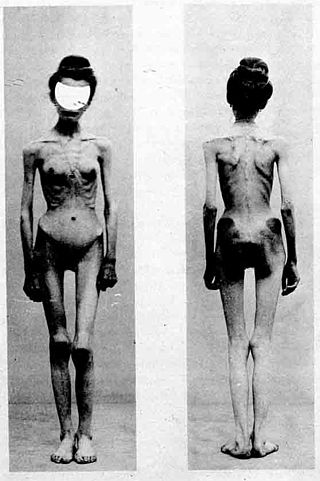An eating disorder is a mental disorder defined by abnormal eating behaviors that adversely affect a person's physical or mental health. Types of eating disorders include binge eating disorder, where the patient eats a large amount in a short period of time; anorexia nervosa, where the person has an intense fear of gaining weight and restricts food or overexercises to manage this fear; bulimia nervosa, where individuals eat a large quantity (binging) then try to rid themselves of the food (purging); pica, where the patient eats non-food items; rumination syndrome, where the patient regurgitates undigested or minimally digested food; avoidant/restrictive food intake disorder (ARFID), where people have a reduced or selective food intake due to some psychological reasons; and a group of other specified feeding or eating disorders. Anxiety disorders, depression and substance abuse are common among people with eating disorders. These disorders do not include obesity. People often experience comorbidity between an eating disorder and OCD. It is estimated 20–60% of patients with an ED have a history of OCD.

Bulimia nervosa, also known as simply bulimia, is an eating disorder characterized by binge eating followed by purging or fasting, and excessive concern with body shape and weight. This activity aims to expel the body of calories eaten from the binging phase of the process. Binge eating refers to eating a large amount of food in a short amount of time. Purging refers to the attempts to get rid of the food consumed. This may be done by vomiting or taking laxatives.
Promotion of anorexia is the promotion of behaviors related to the eating disorder anorexia nervosa. It is often referred to simply as pro-ana or ana. The lesser-used term pro-mia refers likewise to bulimia nervosa and is sometimes used interchangeably with pro-ana. Pro-ana groups differ widely in their stances. Most claim that they exist mainly as a non-judgmental environment for anorexics; a place to turn to, to discuss their illness, and to support those who choose to enter recovery. Others deny anorexia nervosa is a mental illness and claim instead that it is a lifestyle choice that should be respected by doctors and family.

Sociology of the body is a branch of sociology studying the representations and social uses of the human body in modern societies.
Nicola Rachele-Beth Grahame was an English television personality and author. She was a contestant on the seventh series of the reality show Big Brother in 2006, which she finished in fifth place. Following the show, she starred in her own reality series Princess Nikki, and won a National Television Award for Most Popular TV Contender. In 2010, Grahame was runner-up in Ultimate Big Brother, and in 2015, she appeared as a guest housemate on the sixteenth series of Big Brother. In 2016, she competed in the fourth season of Big Brother Canada, finishing in sixth place.

Some claim that the history of anorexia nervosa begins with descriptions of religious fasting dating from the Hellenistic era and continuing into the medieval period. A number of well known historical figures, including Catherine of Siena and Mary, Queen of Scots are believed to have suffered from the condition. Others link the emergence of anorexia to the distinctive presence of an extreme fear of being overweight despite being underweight which emerged in the second half of the 19th century and was first observed by Jean Martin Charcot and other French psychiatrists at the Salpetrière
Wannarexia, or anorexic yearning, is a label applied to someone who claims to have anorexia nervosa, or wishes they did, but does not. These individuals are also called wannarexic, "wanna-be ana" or "anorexic wannabe". The neologism wannarexia is a portmanteau of the latter two terms. It may be used as a pejorative term.

Mara Selvini Palazzoli (1916–1999) was an Italian psychiatrist and founder in 1971, with Gianfranco Cecchin, Luigi Boscolo and Giuliana Prata, of the systemic and constructivist approach to family therapy which became known as the Milan family systemsapproach and more generally, the school of systemic family therapy. They were variously called the Milan Team or the Milan Associates. Mara Selvini Palazzoli and the Milan Team worked with serious psychiatric disorders in families with anorexic and schizophrenic members.

Hilde Bruch was a German-born American psychiatrist and psychoanalyst, known foremost for her work on eating disorders and obesity.

Anorexia mirabilis, also known as holy anorexia or inedia prodigiosa or colloquially as fasting girls, is an eating disorder, similar to that of anorexia nervosa, that was common in, but not restricted to, the Middle Ages in Europe, largely affecting Catholic nuns and religious women. Self-starvation was common among religious women, as a way to imitate the suffering of Jesus in his torments during the Passion, as women were largely restricted to causing themselves voluntary pain by fasting, whereas holy men experienced suffering through physical punishment.
Blaesilla, also known as Blesilla (364–384), was a Roman widow and disciple of Jerome. She was born into a wealthy senatorial family in Rome, the eldest daughter of Paula of Rome and sister of Eustochium, who were members of a group of wealthy Christian women who followed the teachings of Jerome. Blaesilla was widowed at the age of 18; at first, she enjoyed her freedom as a widow, but after a life-threatening fever, became "a changed woman" and a severe ascetic, practicing fasting as a spiritual discipline. Her fasts dramatically weakened her, and she died within four months, at the age of 20.
The differential diagnoses of anorexia nervosa (AN) includes various types of medical and psychological conditions, which may be misdiagnosed as AN. In some cases, these conditions may be comorbid with AN because the misdiagnosis of AN is not uncommon. For example, a case of achalasia was misdiagnosed as AN and the patient spent two months confined to a psychiatric hospital. A reason for the differential diagnoses that surround AN arise mainly because, like other disorders, it is primarily, albeit defensively and adaptive for, the individual concerned. Anorexia Nervosa is a psychological disorder characterized by extremely reduced intake of food. People with anorexia nervosa tend to have a low self-image and an inaccurate perception of their body.
Exercise addiction is a state characterized by a compulsive engagement in any form of physical exercise, despite negative consequences. While regular exercise is generally a healthy activity, exercise addiction generally involves performing excessive amounts of exercise to the detriment of physical health, spending too much time exercising to the detriment of personal and professional life, and exercising regardless of physical injury. It may also involve a state of dependence upon regular exercise which involves the occurrence of severe withdrawal symptoms when the individual is unable to exercise. Differentiating between addictive and healthy exercise behaviors is difficult but there are key factors in determining which category a person may fall into. Exercise addiction shows a high comorbidity with eating disorders.
Cognitive emotional behavioral therapy (CEBT) is an extended version of cognitive behavioral therapy (CBT) aimed at helping individuals to evaluate the basis of their emotional distress and thus reduce the need for associated dysfunctional coping behaviors. This psychotherapeutic intervention draws on a range of models and techniques including dialectical behavior therapy (DBT), mindfulness meditation, acceptance and commitment therapy (ACT), and experiential exercises.
Claire V. Wiseman is an assistant clinical professor of psychology at the Yale School of Medicine and a practicing clinical Psychologist and researcher who specializes in eating disorders and adolescent body image.
Body image disturbance (BID) is a common symptom in patients with eating disorders and is characterized by an altered perception of one's own body.
"Nothing tastes as good as skinny feels" is a quote popularized by English model Kate Moss, though she did not originate the phrase. Moss first publicly used the quote in a 2009 interview with Women's Wear Daily where she stated it was one of her mantras. The quote was immediately controversial, and subsequently used for pro-anorexia purposes. It has also been used for product marketing and been the focus of academic study. Moss later expressed regret for using the phrase.
Lene Marie Fossen was a Norwegian photographer and artist.




